Global issues that impact on vision loss
Click here to see our interactive maps of issues that impact vision loss
Many of us fear losing any of our senses, but our sight is particularly important to us since it is how we engage with the world around us. But vision loss is a huge problem for many people in countries all around the world, and there are a number of issues that directly impact the number of people who lose their sight. In this post, we’re looking at vision loss, considering how screen time and gaming affect the eyes, as well as looking at smoking rates, air pollution, and diabetes prevalence in countries worldwide, and why they are important to consider.
How big a problem is vision loss worldwide?
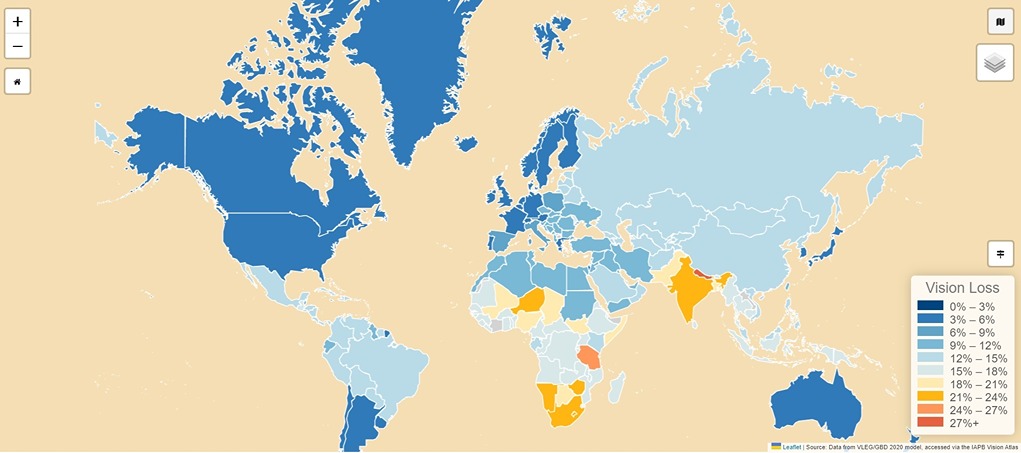
Vision loss is a huge problem for individuals and healthcare professionals around the world. 1.1 billion people are living with vision loss worldwide, with at least 2.2 billion people experiencing near or distant vision impairment. Half of these cases could have been prevented, or have yet to be addressed. These include people with moderate or severe distance vision impairment or blindness due to unaddressed refractive error (88.4 million), cataracts (94 million), glaucoma (7.7 million), corneal opacities (4.2 million), diabetic retinopathy (3.9 million), and trachoma (2 million), as well as near vision impairment caused by unaddressed presbyopia (826 million).
Nepal 27.2%
Tanzania – 25.1%
Niger – 22.8%
Zimbabwe – 22.8%
India – 22.7%
South Africa – 21.6%
Namibia – 21.1%
Botswana – 21%
Bangladesh – 19.3%
Pakistan – 19%
Vision impairment has a huge impact on the individual, but there are also economic impacts. The WHO estimates that annual global costs of productivity losses associated with vision impairment from uncorrected myopia and presbyopia alone were estimated to be US$ 244 billion and US$ 25.4 billion, respectively.
Considering that by 2050, it is expected that an estimated 1.8 billion people will be living with untreated vision loss, this will have an even bigger impact on the countries that are already experiencing high rates of vision loss. The countries most impacted at present are low- and medium-income countries, with much of Africa, as well as the South Asia industrial countries of India, Pakistan, and Bangladesh being impacted significantly.
Is screen time really an issue?
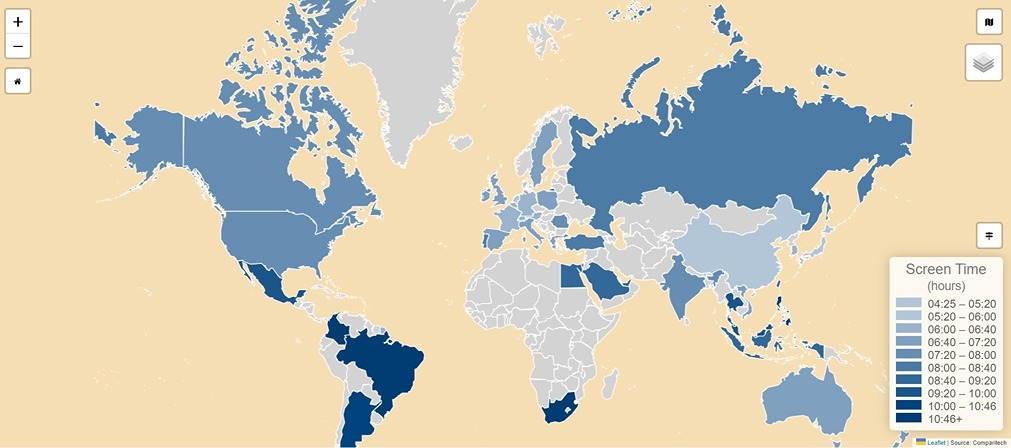
We hear a lot about screen time today, and in many devices, there is now inbuilt functionality to help us monitor how much time we spend using it each day. While there are social and personal reasons that we might want to monitor our use of technology, is there really a good reason to limit our screen time for the sake of our eyes?
The old wives’ tale that watching too much TV will make your eyes go square has certainly never come to pass, but will sitting too close to the screen damage your eyes? Screen time was first mentioned in terms of the amount of TV and video games that were being watched in the 1990s when it was used by Tom Engelhardt in an article about the amount of time children spent watching or playing. On average, today the average person spends around seven hours a day on screens connected to the internet.
South Africa 10.46 hours
Philippines 10.27 hours
Brazil 10.19 hours
Colombia 10.03 hours
Argentina 9.38 hours
Thailand 9.6 hours
Malaysia 9.10 hours
Indonesia 8.37 hours
Mexico 8.55 hours
Taiwan 8.07 hours
Excessive screen time can cause eye fatigue, dry and irritated eyes, loss of focus flexibility, near-sightedness, and retinal damage from the blue light on screens. This is known to lead to early age-related macular degeneration, which can cause loss of eyesight. In a world that is increasingly connected to screens and the internet, the health of our eyes should be considered when we’re using our technology, and we should take steps to protect our eyes from becoming damaged.
How big is the gamer population worldwide?
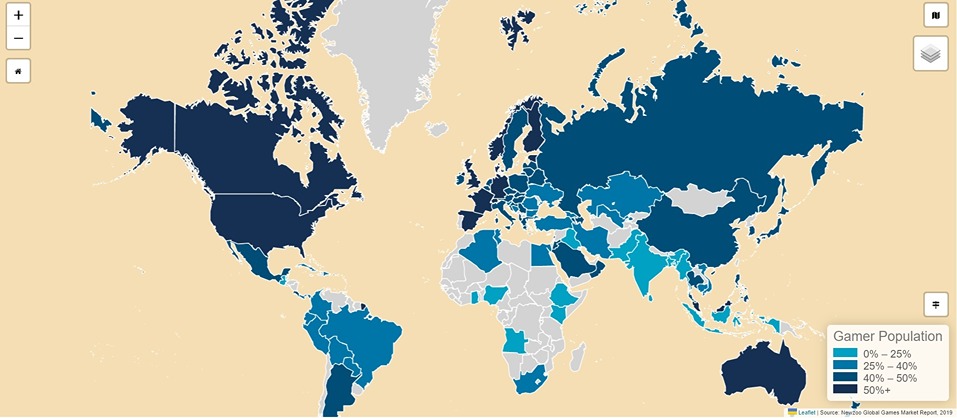
There are few surprises on the countries that have the most gamers, but out of the countries that spend the most time on their screens, only Malaysia features on the list of countries with high numbers of gamers. This requires further investigation, but suggests that countries with high screen time are working longer hours, rather than gaming. In Malaysia, in addition to eye care concerns, there are likely to be other health concerns due to inactivity, especially where workers are spending time at their workstations, and then moving to gaming setups for long periods.
The majority of the countries with 60% of the population that identify as gamers are in developed countries with high GDP.
Australia 60%
Canada 60%
Finland 60%
France 60%
Germany 60%
Malaysia 60%
Norway 60%
Spain 60%
United Kingdom 60%
USA 60%
There is some evidence to suggest that first-person action games can help to improve spatial resolution, which may be helpful when rehabilitating conditions such as lazy eye and cataracts. While an hour of playing computer games may be beneficial, three or more hours in one go will negate those benefits.
Since playing computer games involves using a screen, issues such as dry eyes, eye fatigue, irritation, near-sightedness, and retinal damage from blue light all remain a risk for gamers.
Are smoking rates a problem for the eyes?
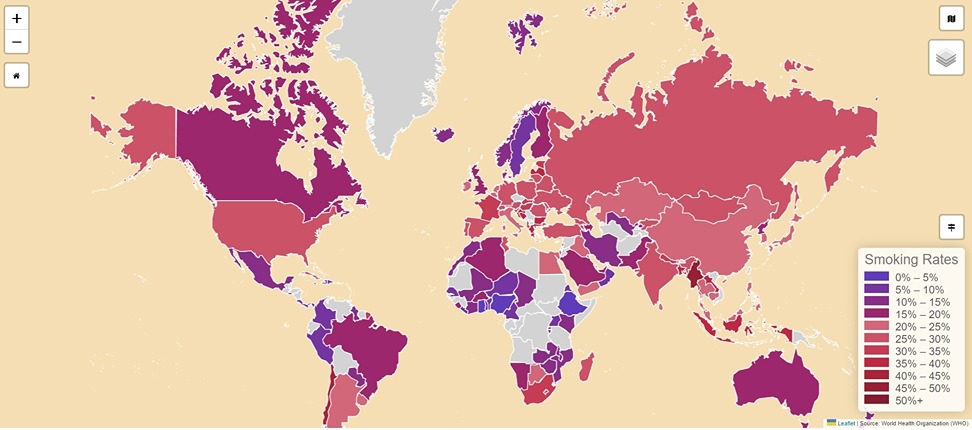
Despite all the scientific research and increased awareness of the dangers of smoking worldwide, smoking rates still remain high in many countries. In the five countries that have the most smokers, more than a third of the adult population smokes and in the following five, more than a quarter of the population smokes.
Myanmar 45.5%
Chile 44.7%
Indonesia 37.9%
Laos 37.8%
France 34.6%
South Africa 31.4%
Georgia 29.7%
Turkey 29.3%
Russia 28.3%
India 27%
Interestingly though, male and female smoking rates are not nearly equal worldwide.
• In Myanmar, just over 70% of men smoke, while just over 20% of women smoke.
• In Indonesia, just 5.3% of women smoke, while 70.5% of men do.
• In Laos, 60.1% of men compared to 15.5% of women.
• In Georgia, Turkey, and Russia, the rates of men smoking compared to women are much higher too.
• In India, 42% of men and just 12.1% of women are smokers.
• In South Africa, rates are similar to India, at 46.8% of men smoking compared to 16% of women.
This begs the question: why are men continuing to smoke at higher rates than women in these countries, when it is not the case in other countries? In Chile, smoking rates between men and women are much closer – 49.2% as opposed to 40.3% of men and women respectively, while in France they are even closer, at 36% to 33.2%. France is well known for high rates of smoking amongst the population, despite smoking having been banned in enclosed public places introduced in 2007, with vaping also being included in bans.
There are almost certainly social, cultural, and financial reasons for higher rates of men smoking in some countries, while in others, rates of female smokers remain high. Research into these reasons would be likely to help inform stop smoking campaigns and strategies. Encouraging people to stop smoking is important, and not just for the body, and the potential expense it has on the country’s health service. The effects of smoking on the body are well documented, and with the eyes, the effects can be just as severe.
• Particles in tobacco smoke act as irritants to the conjunctiva.
• Cigarette smoke can lead to an acute constriction of the ciliary arteries, reducing blood flow to the eye.
• Nicotine and carbon monoxide can cause fatty deposits in blood vessels.
• Increased platelet aggregation and blood clotting can affect the ophthalmic branch of the carotid vasculature, which may also cause ocular ischemic episodes.
• Tobacco smoke can cause oxidative damage to the retina.
• Heavy metals in tobacco smoke can accumulate in the lens, causing the formation of cataracts.
Smokers have an increased risk of developing eye conditions such as age-related macular degeneration (AMD), Graves’ disease, age-related cataracts, optic neuropathy, optic neuritis, diabetic retinopathy, abnormal eye movements and amblyopia.
What impact does air pollution have on the eyes?
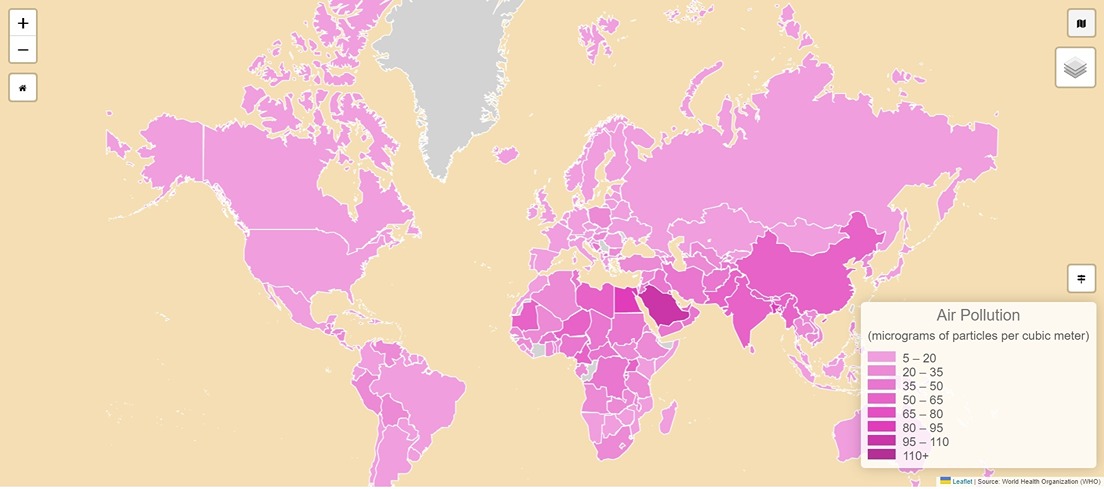
The World Health Organisation recommends a maximum of 10 µg/m3 as being safe for humans, and there are a number of countries where air pollution is an issue. In Saudi Arabia, the air quality is ten times this level, owing to urbanisation and high carbon emissions from petrol cars (there is no public transport in many cities).
Other countries with high levels of air pollution are low- and middle-income countries, several of which have high levels of traffic and large populations, as well as manufacturing industries. WHO states that household combustion devices, motor vehicles, industrial facilities and forest fires are the most common sources of air pollution – all of which are prevalent in these countries. In poor and rural areas, wood is relied upon as fuel for cooking and heating, which contributes to air pollution too.
Saudi Arabia 108
Egypt 93
Bangladesh 84
Cameroon 65
Mauritania 65
Nepal 64
India 62
Libya 61
Pakistan 60
Uganda 57
Measurements in micrograms of particles per cubic meter
Air pollution has adverse effects on the human body, including cardiovascular disorders, respiratory tract problems, ocular disease, neurologic disease, cancer, and ultimately, death. However, due to the thin layer of precorneal tear film, the eyes are particularly susceptible to the adverse effects of air pollution. Irritants and inflammation can cause issues such as allergic conjunctivitis and glaucoma, while age-related macular degeneration (AMD) is known to be related to exposure to traffic-related air pollutants. However, only a limited number of studies have investigated the relationship between air pollution and ocular diseases, and more research is required.
Diabetes prevalence and the impact on the eyes
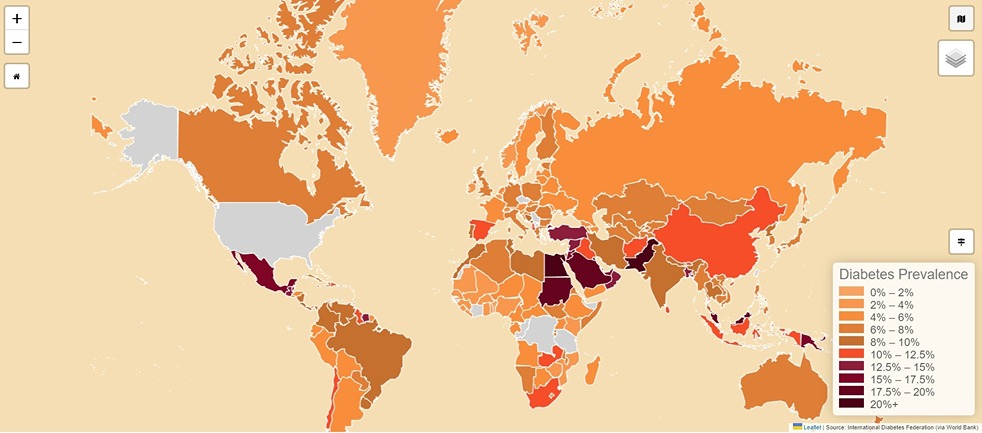
Diabetes is a chronic disease that occurs when the pancreas doesn’t produce enough insulin, or when the body can’t effectively use the insulin that is produced. It is a serious condition, and in 2019, it was the direct cause of 1.5 million deaths, with 49% of these deaths occurring before the age of 70.
There are three main types of diabetes of concern:
• Type 2, which is usually the result of excess body weight and physical inactivity.
• Type 1, which affects around 9 million people, primarily those who live in high-income countries. The cause and the means to prevent it are currently unknown.
• Gestational diabetes, which occurs during pregnancy, can cause complications during pregnancy and at delivery.
Rates of diabetes worldwide are known to be rising more rapidly in low- and middle-income countries than in high-income countries. The World Health Organisation is known to be building awareness on the increase of diabetes with World Diabetes Day on 14th November, and in April 2021 launched the Global Diabetes Compact, which aims for improvements in prevention and care, and specifically aims to support low and middle-income countries.
Pakistan 30.8%
Kuwait 24.9%
New Caledonia 23.4%
Egypt 20.9%
Solomon Islands 19.8%
Malaysia 19%
Saudi Arabia 18.7%
Sudan 18.9%
Fiji 17.7%
Mexico 16.9%
Rates of diabetes are of particular concern for ophthalmologists because of the impact the condition can have on the eyes. In the short term, high glucose levels can cause swelling in the eye tissues which can cause blurred vision. If this continues over a longer period, the blood vessels at the back of the eyes can be damaged, causing scarring and high pressure in the eye. Diabetic eye disease is known to cause conditions such as diabetic retinopathy, diabetic macular edema, cataracts and glaucoma. These are all preventable by managing diabetes, but these are expected to be much higher in countries with high rates of diabetes, and in countries where access to healthcare and eye specialists is difficult.
Why are these issues important to tackle for eye health worldwide?
With each of these issues presenting significant threats to the health of the eyes, it is essential for governments and healthcare services to promote awareness of the issues. Doing so will help to reduce the impact of them, which in turn will help to reduce levels of vision impairment and blindness worldwide. With the potential costs being high – personally, and financially for the individual and their family, as well as the impact of sight loss on the economy of each country, and indeed, the world – there is a lot at stake, and it is well worth the time and investment in reducing preventable sight loss.
Click here to see our interactive maps of issues that impact vision loss
References
East West Eye Institute. (2015, February 27). Do Video Games Hurt Your Eyes? Retrieved from East West Eye Institute: https://eastwesteye.com/video-games-harmful-eyes/
Fong GT, C. L. (2013). Evaluation of the smoking ban in public places in France one year and five years after its implementation: Findings from the ITC France survey. PubMed, 217-223.
IQAir. (2022, 10 7). https://www.iqair.com/saudi-arabia. Retrieved from IQAir: https://www.iqair.com/saudi-arabia
Lin, C. C. (2022). The Adverse Effects of Air Pollution on the Eye: A Review. International journal of environmental research and public health, 1186.
National Institute of Diabetes and Digestive and Kidney Diseases. (2017, May). Diabetic Eye Disease. Retrieved October 7, 2022, from https://www.niddk.nih.gov/health-information/diabetes/overview/preventing-problems/diabetic-eye-disease
Royal Free London NHS Foundation Trust. (2022, October 7). Smoking and your eyes. Retrieved from Royal Free London NHS Foundation Trust: https://www.royalfree.nhs.uk/services/services-a-z/stop-smoking-service/smoking-and-your-eyes/
University of Michigan Health. (2021, February 17). The Lancet Global Health: Vision loss could be treated in one billion people worldwide, unlocking human potential and accelerating global development. Retrieved from Michigan Medicine: https://www.uofmhealth.org/news/archive/202102/lancet-global-health-vision-loss-could-be-treated-one
UPMC Health Beat. (2022, October 7). Is Screen Time Really Bad for Our Eyes? Retrieved from UPMC Health Beat: https://share.upmc.com/2019/01/screen-time/
World Health Organization . (2021, October 14). Blindness and vision impairment. Retrieved from World Health Organization: https://www.who.int/news-room/fact-sheets/detail/blindness-and-visual-impairment
World Health Organization . (2022, October 7). Air Pollution. Retrieved from World Health Organization : https://www.who.int/health-topics/air-pollution#tab=tab_1
World Health Organization . (2022, September 16). Diabetes. Retrieved from World Health Organization : https://www.who.int/news-room/fact-sheets/detail/diabetes
Author: John Dreyer Optometrist Bsc(Hons), MCOPTOM, DipCLP
Created: 30 Oct 2022, Last modified: 7 Jan 2025

